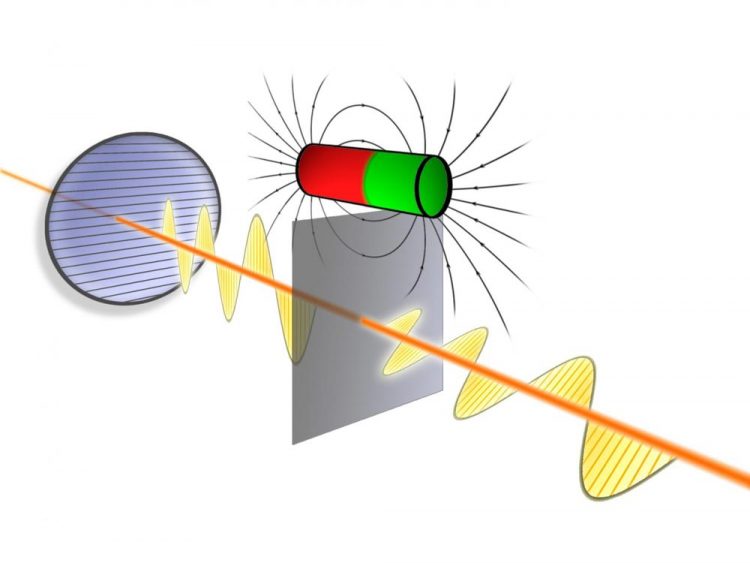Measured for the first time: Direction of light waves changed by quantum effect

In certain materials, light waves can change their direction of polarization. Credit: TU Wien
A light wave sent through empty space always oscillates in the same direction. However, certain materials can be used to rotate the direction in which the light is oscillating when placed in a magnetic field. This is known as a 'magneto-optical' effect.
After much speculation spanning a long period of time, one variant of this type of effect has now been demonstrated at TU Wien for the first time. Rather than switching the direction of the light wave continually, special materials called 'topological insulators' do so in quantum steps in clearly defined portions.
The extent of these quantum steps depends solely on fundamental physical parameters, such as the fine-structure constant. It may soon be possible to measure this constant even more accurately using optical techniques than is currently possible via other methods. The latest findings have now been revealed in the open-access journal 'Nature Communications'.
Topological insulators
“We have been working on materials that can change the direction of oscillation of light for some time now,” explains Prof. Andrei Pimenov from the Institute of Solid State Physics at TU Wien. As a general rule, the effect depends on how thick the material is: the larger the distance to be travelled by the light in the material, the larger the angle of rotation.
However, this is not the case for the materials that Pimenov's team has now investigated more closely with the assistance of a research group from Würzburg. Their focus has been on 'topological insulators', for which the crucial parameter is the surface rather than the thickness.
Insulators on the inside, electricity can usually be conducted very effectively along the surface of a topological insulator. “Even when sending radiation through a topological insulator, the surface is what makes all the difference,” says Pimenov. When light propagates in this material, the oscillation direction of the beam is turned by the surface of the material twice – once when it enters and again when it exits.
What is most remarkable here is that this rotation takes place in particular portions, in quantum steps, rather than being continuous. The interval between these points is not determined by the geometry or by properties of the material and is instead defined only by fundamental natural constants.
For example, they can be specified on the basis of the fine-structure constant, which is used to describe the strength of the electromagnetic interaction. This could open up the possibility of measuring natural constants with more precision than has previously been the case and may even lead to new measuring techniques being identified.
Increased measurement precision using special materials
The situation is similar for the quantum Hall effect, which is another quantum phenomenon observed in certain materials, in which case a particular variable (here electrical resistance) can rise only by certain amounts. The quantum Hall effect is currently used for high-precision measurements, with the official standard definition of electrical resistance being based on it. Back in 1985, the Nobel Prize in Physics was awarded for the discovery of the quantum Hall effect.
Topological materials have also already been the subject of a Nobel Prize victory – this time in 2016. It is expected that these latest results will also make it possible for materials with special topological characteristics (in this case topological insulators) to be used for specific technical applications.
Further information:
Prof. Andrei Pimenov
Institute for Solid State Physics
TU Wien
Wiedner Hauptstraße 8-10, 1040 Vienna
T: +43-1-58801-137 23
andrei.pimenov@tuwien.ac.at
Media Contact
All latest news from the category: Physics and Astronomy
This area deals with the fundamental laws and building blocks of nature and how they interact, the properties and the behavior of matter, and research into space and time and their structures.
innovations-report provides in-depth reports and articles on subjects such as astrophysics, laser technologies, nuclear, quantum, particle and solid-state physics, nanotechnologies, planetary research and findings (Mars, Venus) and developments related to the Hubble Telescope.
Newest articles

NASA: Mystery of life’s handedness deepens
The mystery of why life uses molecules with specific orientations has deepened with a NASA-funded discovery that RNA — a key molecule thought to have potentially held the instructions for…

What are the effects of historic lithium mining on water quality?
Study reveals low levels of common contaminants but high levels of other elements in waters associated with an abandoned lithium mine. Lithium ore and mining waste from a historic lithium…

Quantum-inspired design boosts efficiency of heat-to-electricity conversion
Rice engineers take unconventional route to improving thermophotovoltaic systems. Researchers at Rice University have found a new way to improve a key element of thermophotovoltaic (TPV) systems, which convert heat…



